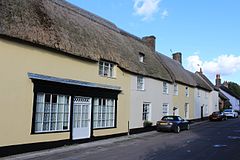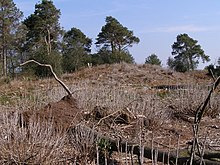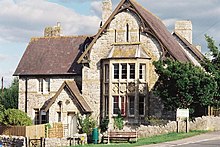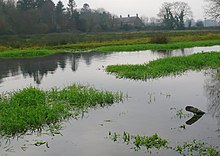Puddletown
| Puddletown | |
|---|---|
 The Square, Puddletown | |
Location withinDorset | |
| Population | 1,452 (2014 estimate) |
| OS grid reference | SY758943 |
| Civil parish | |
| Unitary authority | |
| Shire county | |
| Region | |
| Country | England |
| Sovereign state | United Kingdom |
| Post town | DORCHESTER |
| Postcode district | DT2 |
| Dialling code | 01305 |
| Police | Dorset |
| Fire | Dorset and Wiltshire |
| Ambulance | South Western |
| UK Parliament | |
Puddletownis a village in thecivil parishofAthelhampton and Puddletown,inDorset,England. It is situated by theRiver Piddle,from which it derives its name, about 4.5 miles (7 km) northeast of the county townDorchester.Its earlier namePiddletownfell out of favour, probably because of connotations of the word "piddle". The name Puddletown was officially sanctioned in the late 1950s. Puddletown's civil parish covers 2,908 hectares (7,185 acres) and extends to theRiver Frometo the south. In 2013, the estimated population of the civil parish was 1450.
Puddletown's parish church has significant architectural interest, particularly its furnishings and monuments. It has a 12th-centuryfontand well-preserved woodwork, including 17th-centurybox pews.Thomas Hardytook an interest in the church, and the village provided the inspiration for the fictional settlement of Weatherbury in his novelFar from the Madding Crowd;Weatherbury Farm, the home of principal character Bathsheba Everdene, is based on amanor housewithin the parish.
Toponymy
[edit]The namePuddletownmeans 'farmstead on the River Piddle'. It derives from theOld Englishpidele,a river-name meaning 'fen' or 'marsh', andtūn,meaning 'farmstead'.[1]Several settlements along the river derive their names from it. In the upper reaches,PiddletrenthideandPiddlehintonretain thePiddleriver name, whereas downstream Puddletown,Tolpuddle,Affpuddle,BriantspuddleandTurners PuddleusePuddle.In theDomesday Bookof 1086 it was recorded asPitretone,and in 1212 it wasPideleton.[1]John SpeedusedPuddletownfor his county map of 1610.[2]In 1848Samuel LewisusedPiddletowninA Topographical Dictionary of England.[3]In 1906Sir Frederick TrevesusedPuddletowninHighways & Byways in Dorset—describing it as "the Town on the River Puddle" and a "curiously named place".[4]In 1946Piddletownwas the name on voters lists.[5]One explanation for the preference ofPuddletownoverPiddletownis that Major-General Charles William Thompson, who lived at Ilsington Lodge after returning from theGreat War,pushed through thepuddlevariant becausepiddlehad other connotations in army circles.[6]The broadcaster and writerRalph Wightman(1901–71), a native of the Piddle Valley and one-time Puddletown resident,[6]believed it was due toVictorian"refinement", as he recalled that in his youth elderly aunts referred to Piddletrenthide as just "Trenthide".[5]Roland Gant inDorset Villagesstated more explicitly that the Victorians usedpuddlebecausepiddle"became a euphemism for 'piss'".[7]The use ofPuddletownrather thanPiddletownwas officially preserved in the late 1950s, when, according to Wightman, "a long County Council debate solemnly decided Piddletown should be Puddletown".[5][7]
The other rivers of the parish have names that derive fromCelticriver-names: the Frome, which forms the parish's southern boundary, means 'fair, fine or brisk',[8]and the Devil's Brook, which forms the north-eastern boundary, means 'dark stream'.[9]
History
[edit]
Evidence of prehistoric human occupation in the parish exists in the form of 30round barrows,about half of which are sited overchalkand half overReading Beds.Many of the barrows have been damaged by more recent activities. The remains ofstrip lynchetsof 'Celtic' fields have been found near a few of the barrows. One of the three 'Rainbarrows' on Duddle Heath has been excavated; bucket urns containing cremations from the site were taken to theDorset Museum.[10]
TheRoman roadbetweenDurnovaria(now Dorchester) andBadbury Ringspassed through the area of the civil parish; it cut a WSW-ENE route through Puddletown Heath, between the village and the River Frome.[10]In the 21st century a section of the road, which is 26 metres (85 ft) wide, was discovered in Puddletown Forest.[11]
Part of the arm of a 9th- or 10th-century stone cross was discovered when a house in the village—Styles House, near the River Piddle—was demolished. The cross might have been connected with a meeting place.[12]The fragment was incorporated into the parish church's newchancelwhen it was rebuilt in 1911.[13]
At the time of theDomesday Bookin 1086, Puddletown was a large and importantmanorthat contained several villages, with 1,600 sheep recorded.[14]In the 13th century, during the reign ofHenry III,the manor of 'Pidele Bardolfeston town' was owned byJohn of Monmouth,and leased to Sir Alfred Lincoln: on Monmouth's death, it was inherited by Lady Albretha Boterell and Lady Joan Nevill.[15]
Except for Puddletown village, the several small settlements within Puddletown parish have all either diminished or disappeared. The other settlements were Cheselbourne Ford (beside the Devil's Brook in the northeast of the parish), Bardolfeston (about half a mile northeast of Puddletown village, just north of the River Piddle), Hyde (now Druce Farm), Waterston, South Louvard (now Higher Waterston), Little Piddle (now Little Puddle Farm in neighbouring Piddlehinton parish) and Ilsington (in the south of the parish, by the River Frome). Cheselbourne Ford and Bardolfeston areabandoned.Cheselbourne Ford had a population of six in 1086, four in 1327, and by the mid-seventeenth century was just one ruinous house. In 1970 its remains covered about 5.7 hectares (14 acres) and consisted of ten closes bounded by low banks, though the site is not shown on modernOrdnance Surveymaps. Records indicate that Bardolfeston was declining by the 13th century and, though still occupied in the 16th, it was completely deserted by the 17th century. Its site covers about 6.1 hectares (15 acres) and is well-preserved, revealing a 12 metres (40 ft)-wide hollow way aligned southwest–northeast, with the sites of at least eleven houses alongside, though the southern end of the site was destroyed whenwatermeadowswere later created along the river.[10][16]The site at Waterston consists of earthworks covering about 2 hectares (4.9 acres) on aterraceon the south side of the River Piddle. Its medieval population was relatively stable, and ten households were recorded in 1662. The site was probably abandoned gradually.[17]
In the early 17th century Puddletown was one of the first places in Dorset where the use of watermeadows developed; the practice occurred at least as early as 1620, and in 1629 themanorial courtdecided to allow some tenants to continue making the necessary watercourses that would enable "the watering and Improvinge of theire groundes".[18]Watermeadows are generally no longer used in southern England, though their physical remnants have persisted in many places;[19]in Puddletown civil parish, several areas of watermeadow were shown by the Ordnance Survey as late as 1978, though none was shown in 2010.[16][20]

Records from 1801 show that at that time agriculture was the main component of Puddletown's economy, though cottage industry and artisan crafts were also an important element: 596 people in the parish were primarily employed in agriculture, with 221 employed in handicrafts, manufacture and trade. Cottage industry, often undertaken by women and children, was used to supplement agricultural income, though there were fewer opportunities for this after theFrench Revolution.[21]
In 1830, Puddletown was one of the places in Dorset where agricultural labourers took part in theCaptain Swing riotsof southern England, protesting against very low wages and long working hours.Threshing machineswere damaged andricksburned. Wages were raised from about six or sevenshillingsper week to ten as a result.[22]
To the east of the church is Ilsington House, also known as the Old Manor, which was built in the late 17th to early 18th century.[23]It was originally owned by the3rd Earl of Huntingdonand in 1724 byRobert Walpole.Between 1780 and 1830 it was leased toGeneral Thomas Garth,principal equerry toKing George III.The General adopted King George III's illegitimate grandson byPrincess Sophia,and brought him up at the manor.[6]In 1861 the house was acquired by John Brymer and remained in the possession of theBrymer familyfor the next century.[6][24]The family built new cottages and a reading room in the village, and a new manor next to the church, which they restored.[25]
Governance
[edit]In local government, Puddletown is governed byDorset Councilat the highest tier, and Puddletown AreaParish Councilat the lowest tier.[26]Puddletown is part of thePuddletown and Lower Winterborne wardwhich elects 1 member toDorset Council.[27]
In the UK national parliament, Puddletown is within theWest Dorset parliamentary constituency.
Historically, Puddletown was in theDorchester Rural Districtfrom 1894 to 1974,[28]and theWest Dorsetdistrict from 1974 to 2019. On 1 April 2024 the parish was abolished and merged withAthelhamptonto form "Athelhampton and Puddletown".[29]
Geography
[edit]
Puddletown civil parish extends between theflood plainandwatermeadowsof theRiver Fromein the south to the chalkwatershedof Puddletown Down in the north.[16][30]It covers 2,908 hectares (7,185 acres) and is bisected by the River Piddle, which crosses it from west to east.[10]Measured directly, Puddletown village is about 4.5 miles (7.2 km) northeast of Dorchester, 16 miles (26 km) west ofPooleand 11 miles (18 km) southwest ofBlandford Forum.[31]
The bedrock geology of the parish comprises rocks formed in theSantonianandCampanianages of theCretaceousperiod and theEoceneage of thePalaeogeneperiod. In places these are overlain by youngerQuaternarydrift material:river terraceandheaddeposits, clay-with-flints,andalluvium—the last found only in the valley floors of the larger watercourses.[30]On Puddletown Heath (now mostly covered by Puddletown Forest) are more than 370 solution hollows orsinkholes;these constitute the largest concentration of hollows on the heathlands in the area.[32]
The River Frome, which forms the southern boundary of the parish, is designated byNatural Englandas aSite of Special Scientific Interest.[33]Southwest of the village and almost wholly within the parish is Puddletown Forest, which covers 301 hectares (740 acres) and is managed byForestry England.The forest is on the edge of theDorset HeathsNatural Area and some of the forest is being restored to heathland; the heath flora consists ofCalluna,Ulex gallii,Ulex minorandbilberry;fauna includes the raresmooth snakeandsand lizard.Close to Puddletown Forest are Yellowham Wood and Ilsington Wood, which areancient woodlandsites, though Ilsington Wood has significant conifer plantings.[34]
Demography
[edit]In 2014 the estimated population of Puddletown civil parish was 1,452.[35]Figures from the2011 censushave been published for Puddletown parish combined with the small parish ofAthelhamptonto the east; in this area there were 663 dwellings,[36]614 households and a population of 1,405.[37]
Notable buildings
[edit]Excluding ancient earthworks, there are fifty-six structures within the parish that arelistedbyHistoric Englandfor their historic or architectural interest, including two (the parish church andWaterston Manor) that are listed as Grade I, and three (Ilsington House, The Old Vicarage, and 8 The Square) that are Grade II*.[38][39]

Puddletown's parish church, dedicated to St Mary, has been described as being "of considerable architectural interest",[10]"of exceptional interest for its furnishings and monuments"[40]and "one of the most exciting parish churches in the county".[41]It has 12th-century origins—parts of the tower date from 1180 to 1200[41]—but was rebuilt and enlarged between the 13th and 16th centuries.[10][40]The 12th-centuryfontis particularly notable, being of a tapering beaker shape, withdiaperingdepicting crossing stems andAcanthusleaves;its cover is an octagonal pyramid dating from about 1635, when the church interior was refitted.[6][10]There is a panelled roof in thenave,and 17th-centurybox pews,pulpit and gallery. There are also a number of 15th- and 16th-century monumental brasses and some stained glass byNinian Comper.[42]The South or Martyn family chapel has three 16th-century tombs with alabaster effigies. In 1910 the church was partiallyrestoredbyCharles Ponting.[10][40]Thomas Hardy led an unsuccessful campaign to prevent enlargement of the originalchancel.[41]
Waterston Manor, about 1.5 miles (2.4 km) WNW of Puddletown village, is of early 17th-century origin, though it was largely rebuilt after a fire in 1863, and altered again in about 1911.[43]
Ilsington House dates from the late 17th to early 18th century, with alterations made in the late 18th to early 19th century and enlargement later in the 19th. It hasplaster-covered brick walls,quoinsofashlar,and ahippedslate roof.[23]In 2000 it was presented with a "Dorset Architectural Heritage Award".[24]
The Old Vicarage, previously the east wing of the vicarage, was originally atimber-framedbuilding built about 1600. It was clad in brick in the 18th century (after the vicarage had been extended west in 1722) and a third storey added early in the 19th century. The 1722 west-wing extension became 8 The Square and is listed separately.[10][44][45]

Community facilities
[edit]Puddletown has avillage hall,which has a kitchen and bar, full disabled facilities and access, and a capacity for between 100 and 160.[46]Since 2013 it has also housed Puddletown Community Library, which is operated solely by volunteers.[47]On Athelhampton Road there is adoctor's surgery,which also treats patients who live in surrounding villages.[48]Puddletown has arecreation groundon Three Lanes Way; it has one cricket pitch and two grass football pitches (one junior, one full-size).[49]
Literary connections
[edit]Puddletown is the basis for the village of "Weatherbury" inThomas Hardy's novelFar from the Madding Crowd.[6]Weatherbury Farm, the house of Bathsheba Everdene, is based on Waterston Manor, between Puddletown and Piddlehinton.[50]Hardy's cousin,Tryphena Sparks,who was the inspiration for Hardy's poemThoughts of Phena at News of Her Death,lived in Puddletown.[51]
Notable people
[edit]Cardinal Pole,the lastRoman CatholicArchbishop of Canterbury,was vicar of the parish from 1532 to 1536.[41]The author and broadcasterRalph Wightman(1901–1971) lived in Puddletown in the later years of his life; he lived in the 16th-century Tudor Cottage in The Square.[6][10]The writerConstantine Fitzgibbon(1919–1983) owned Waterston Manor for part of the 20th century.[50]
See also
[edit]References
[edit]Notes
[edit]- ^abMills, David (2011).A Dictionary of British Place Names.Oxford University Press. p. 377.ISBN978-0-19-960908-6.
- ^"John Speed's Map of Dorset 1610".Charmouth Local History Society.Retrieved13 May2017.
- ^Lewis, Samuel (1848).A Topographical Dictionary of England.British History Online. pp. 567–571.Retrieved13 May2017.
- ^Treves, Sir Frederick (1906).Highways & Byways in Dorset.Macmillan and Co. Ltd. pp.365–6.
- ^abcWightman 1983,p. 70.
- ^abcdefgHannay, Clive; Legg, Rodney (September 2006)."Puddletown".Dorset Life Magazine.Retrieved23 August2015.
- ^abGant 1980,p. 188.
- ^Mills, David (2011).A Dictionary of British Place Names.Oxford University Press. p. 196.ISBN978-0-19-960908-6.
- ^Mills, David (2011).A Dictionary of British Place Names.Oxford University Press. p. 152.ISBN978-0-19-960908-6.
- ^abcdefghij"'Puddletown', in An Inventory of the Historical Monuments in Dorset, Volume 3, Central (London, 1970), pp. 222–231 ".British History Online.University of London.Retrieved1 March2015.
- ^MacDonagh, Diarmuid (29 January 2011)."Roman road found in Puddletown Forest".dorsetecho.co.uk.Newsquest Media (Southern) Ltd.Retrieved31 August2015.
- ^Baker, John; Brookes, Stuart (2015)."Identifying outdoor assembly sites in early medieval England"(PDF).Journal of Field Archaeology.40(1). University of Nottingham: 3–21.doi:10.1179/0093469014z.000000000103.ISSN0093-4690.S2CID145319552.
- ^Cramp, Rosemary (2006).Corpus of Anglo-Saxon Stone Sculpture: South-West England.British Academy. p. 108.ISBN9780197263341.
- ^J H Bettey (1974).Dorset.City & County Histories. David & Charles. pp. 34–39.ISBN0-7153-6371-9.
- ^"Inquisitions Post Mortem, Henry III, File 19 Pages 100-104 Calendar of Inquisitions Post Mortem: Volume 1, Henry III".British History Online.HMSO 1904.Retrieved14 February2023.
- ^abcOrdnance Survey (1978) 1:25,000 Second Series, Sheet SY 69/79 (Dorchester)
- ^"Medieval settlement immediately west of Waterston House".Historic England.Retrieved29 May2017.
- ^J H Bettey."The Development of Water Meadows in Dorset during the Seventeenth Century"(PDF).bahs.org.uk (British Agricultural History Society) (scan). pp. 37–39.Retrieved27 August2015.
- ^Bettey, Joseph (1999). "The Development of Water Meadows in the Southern Counties". In Hadrian Cook; Tom Williamson (eds.).Water Management in the English Landscape(PDF).Edinburgh University Press. pp. 179–195. Archived fromthe original(PDF)on 26 April 2017.Retrieved25 April2017.
- ^Ordnance Survey (2010) 1:25,000 Explorer Series, Sheet 117 (Cerne Abbas & Bere Regis),ISBN978-0-319-24122-6
- ^Ottaway, Susannah R. (2004).The Decline of Life: Old Age in Eighteenth-Century England.Cambridge University Press. pp. 191–192.ISBN9780521815802.Retrieved22 August2015.
- ^J H Bettey (1974).Dorset.City & County Histories. David & Charles. pp. 136–137.ISBN0-7153-6371-9.
- ^ab"Ilsington House, Puddletown".British Listed Buildings.britishlistedbuildings.co.uk.Retrieved1 March2015.
- ^abMaslen, Adrianne (7 July 2010)."Dorset's Ilsington Estate on sale for £18million".dorsetecho.co.uk.Newsquest Media (Southern) Ltd.Retrieved26 August2015.
- ^Wightman 1983,p. 75.
- ^"Welcome to the Puddletown Area Parish Council Website".Puddletown Area Parish Council. Archived fromthe originalon 4 March 2016.Retrieved24 August2015.
- ^"Area profile for Puddletown & Lower Winterborne - Dorset Council".gi.dorsetcouncil.gov.uk.Retrieved24 February2024.
- ^"Dorchester Rural".WeRelate.Retrieved20 August2024.
- ^"Dorset Registration District".UKBMD.Retrieved4 August2024.
- ^abBritish Geological Survey (2000) 1:50,000 Series, Sheet 328 (Dorchester),ISBN0-7518-3310-X
- ^Bartholomew (1980) 1:100,000 National Map Series, Sheet 4 (Dorset),ISBN0-7028-0327-8
- ^Goudie, A. S.; Gardner, R. (2013) [1992].Discovering Landscape in England & Wales.Springer Science & Business Media. pp. 136–7.ISBN978-0-412-47850-5.
- ^"COUNTY: DORSET. SITE NAME: RIVER FROME"(PDF).naturalengland.org.uk. Archived fromthe original(PDF)on 24 September 2015.Retrieved29 August2015.
- ^"Plan Name: Puddletown"(PDF).Forestry Commission.Retrieved6 May2017.[permanent dead link]
- ^"Area Profile for Puddletown & Athelhampton".geowessex.com.Dorset County Council.Retrieved25 December2016.
- ^"Area: Puddletown (Parish). Dwellings, Household Spaces and Accommodation Type, 2011 (KS401EW)".Neighbourhood Statistics.Office for National Statistics. Archived fromthe originalon 2 April 2015.Retrieved1 March2015.
- ^"Area: Puddletown (Parish), Key Figures for 2011 Census: Key Statistics".Neighbourhood Statistics.Office for National Statistics. Archived fromthe originalon 16 March 2014.Retrieved16 March2014.
- ^"Listed Buildings in Puddletown, West Dorset, Dorset".britishlistedbuildings.co.uk.Retrieved31 May2017.
- ^"Search Results for 'Puddletown'".Historic England.Retrieved4 June2017.
- ^abc"Church of Saint Mary, Puddletown".britishlistedbuildings.co.uk.Retrieved26 August2015.
- ^abcd"Puddletown St Mary's".The Dorset Historic Churches Trust. Archived fromthe originalon 23 September 2015.Retrieved26 August2015.
- ^Betjeman, John, ed. (1968)Collins Pocket Guide to English Parish Churches; the South.London: Collins; p. 176
- ^"Waterston Manor, Puddletown".britishlistedbuildings.co.uk.Retrieved24 August2015.
- ^"The Old Vicarage Including Garden Walls Adjoining Islington House, Puddletown".britishlistedbuildings.co.uk.Retrieved26 August2015.
- ^"8 the Square, Puddletown".britishlistedbuildings.co.uk.Retrieved26 August2015.
- ^"Puddletown Village Hall".Dorset Halls Network.Dorset Village Halls Association. 2012.Retrieved30 August2015.
- ^"Welcome to Puddletown Community Library".communitylibrarypuddletown.org.Retrieved31 August2015.
- ^"Puddletown Surgery".puddletownsurgery.co.uk.Retrieved31 August2015.
- ^"Puddletown Recreation Ground".sports-facilities.co.uk.Retrieved30 August2015.
- ^abGant 1980,p. 190.
- ^Millgate, MichaelThomas Hardy: a biography revisited(2004) Oxford University Press,ISBN0-19-927566-1
General references
[edit]- Gant, Roland (1980).Dorset Villages.Robert Hale Ltd.ISBN0-7091-8135-3.
- Wightman, Ralph (1983).Portrait of Dorset(4 ed.). Robert Hale Ltd.ISBN0-7090-0844-9.


